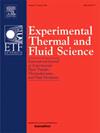Effect of concentration and period on the transient pool boiling heat transfer of Fe3O4-based aqueous nanofluids
IF 2.8
2区 工程技术
Q2 ENGINEERING, MECHANICAL
Experimental Thermal and Fluid Science
Pub Date : 2025-01-10
DOI:10.1016/j.expthermflusci.2024.111404
引用次数: 0
Abstract
The high conductivity of metal nanoparticles and the flowability of the base fluid led to significant changes in heat transfer rates when ferrofluids are used in the boiling process. Pool boiling tests were conducted in this study using Fe3O4/water ferrofluid at concentrations of 0.01 %, 0.05 %, and 0.1 % under transient conditions lasting from 1 s to 5000 s. In the present study, the ferrofluid was prepared through a two-step process. A horizontal nickel-chrome wire served as the heater and the heat flux was assessed as a quadratic polynomial function for each period, with a linear increase in applied voltage. Results showed that increasing nanoparticle concentration accelerates the onset of nucleate boiling (ONB) and raises critical heat flux (CHF) by up to 137 %. However, longer periods lead to delayed ONB, increased superheat temperature, a maximum 25 % reduction in CHF, and a maximum 96 % reduction in heat transfer coefficient at the CHF point in any given nanoparticle concentration. at concentrations of 0.01 %, 0.05 %, and 0.1 %, the heat transfer coefficient at the CHF point experiences a decline of 96.5 %, 95.15 %, and 89.7 %, respectively, with an increased period compared to the baseline period of t = 1 s.
浓度和周期对fe3o4基纳米水流体瞬态池沸腾传热的影响
在沸腾过程中使用铁磁流体时,金属纳米颗粒的高导电性和基液的流动性导致了传热速率的显著变化。本研究使用浓度分别为0.01%、0.05%和0.1%的Fe3O4/水铁磁流体,在持续1秒至5000秒的瞬态条件下进行了池沸试验。本研究采用两步法制备铁磁流体。一根水平镍铬丝作为加热器,每个周期的热流被评估为二次多项式函数,外加电压线性增加。结果表明,纳米颗粒浓度的增加加速了核沸腾(ONB)的发生,临界热流密度(CHF)提高了137%。然而,在任何给定的纳米颗粒浓度下,较长的周期导致ONB延迟,过热温度升高,CHF最大降低25%,CHF点的传热系数最大降低96%。在浓度为0.01%、0.05%和0.1%时,CHF点的换热系数分别下降了96.5%、95.15%和89.7%,且周期较t = 1 s的基线周期有所增加。
本文章由计算机程序翻译,如有差异,请以英文原文为准。
求助全文
约1分钟内获得全文
求助全文
来源期刊

Experimental Thermal and Fluid Science
工程技术-工程:机械
CiteScore
6.70
自引率
3.10%
发文量
159
审稿时长
34 days
期刊介绍:
Experimental Thermal and Fluid Science provides a forum for research emphasizing experimental work that enhances fundamental understanding of heat transfer, thermodynamics, and fluid mechanics. In addition to the principal areas of research, the journal covers research results in related fields, including combined heat and mass transfer, flows with phase transition, micro- and nano-scale systems, multiphase flow, combustion, radiative transfer, porous media, cryogenics, turbulence, and novel experimental techniques.
 求助内容:
求助内容: 应助结果提醒方式:
应助结果提醒方式:


